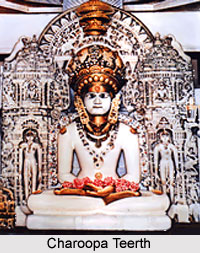 Charoopa Teerth located in Charoopa village in Gujarat is a Jain pilgrimage centre. It is dedicated to Lord Parshvanatha, the twenty-third Jain Tirthankara. The temple is situated in the middle of Charoopa village and is located at a distance of 10 kms from Patan.
Charoopa Teerth located in Charoopa village in Gujarat is a Jain pilgrimage centre. It is dedicated to Lord Parshvanatha, the twenty-third Jain Tirthankara. The temple is situated in the middle of Charoopa village and is located at a distance of 10 kms from Patan.
History of Charoopa Teerth
According to history Charoopa Teerth dates back to the ancient time. It is said that the temple located here is one of the three temples that was installed by Shri Ashadhi Sharavaka. As per records Shri Devachandrasuriji is said to have installed the Parikara of Shri Parshvanath Prabhu in the ninth century. According to another reference one more temple was constructed here in the thirteenth century by Shreshthi Devachandra. The temple was dedicated to the first tirthankara, Bhagwan Rishabh Dev. It is also suggested that Shreshthi Pethadshah got constructed the temple of Shri Shantinath Bhagwan in the year 1320 of the Vikram Samvat Era. After the 18th century the teerth kshetra is in complete dilapidated state. Later the Shravakas of Patan took over the management and reconstruction of the temple in V.S. 1938. With time they built a magnificent and a huge temple. In V.S. 1984 on the day of the bright half of the Jeth month the idol of Lord Parshvanatha was re-installed in the temple. It is believed that here Shri Viracharya, the famous Jain Acharya was invited by king Siddharaj. A grand festival was organised at his arrival and he was welcomed with great respect and honour. Thus Charoopa teerth is associated with many ancient and glorious incidents.
Temple of Charoopa Teerth
The temple of Charoopa Teerth is dedicated to Shri Shyamala Parshvanatha Bhagavan. The temple being very old stands as an example of ancient art and architecture. The idol is 1.20 metres in height and is of black colour. It is seated in a padmasana posture. The idol of the lord is also very old and is regarded to have miraculous powers. The art of the black idol carved from marble is simply unique and looks very appealing. The head of the idol stretching to the shoulders is very vast. It is also covered by hood. The temple organises many annual gatherings and festivals. There is provision for dharamshalas or rest houses for the pilgrims. These are well equipped with all modern facilities. Being located in Gujarat the place is well connected to rail, road and air.









